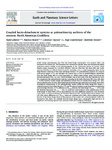Coupled basin-detachment systems as paleoaltimetry archives of the western North American Cordillera
| dc.contributor.author | Gébelin, A | en |
| dc.contributor.author | Mulch, A | en |
| dc.contributor.author | Teyssier, C | en |
| dc.contributor.author | Page Chamberlain, C | en |
| dc.contributor.author | Heizler, M | en |
| dc.date.accessioned | 2017-03-14T15:22:18Z | |
| dc.date.available | 2017-03-14T15:22:18Z | |
| dc.date.issued | 2012-06-15 | en |
| dc.identifier.issn | 0012-821X | en |
| dc.identifier.uri | http://hdl.handle.net/10026.1/8621 | |
| dc.description.abstract |
Stable isotope paleoaltimetry data from the Snake Range metamorphic core complex (MCC) and Sacramento Pass Basin (NV, USA) document that extensional mylonite zones and kinematically linked syntectonic basins reliably record paleotopography in the continental interior of western North America when compared to a sea-level reference. Here we show that this basin-MCC pair tracks meteoric fluid flow at different levels of actively extending crust in a high-topography region during Oligo-Miocene extension of the Basin and Range Province. For paleoaltimetry purposes we compare multi-proxy oxygen (δ 18O) and hydrogen (δD) isotope data as well as geochronological information from the Snake Range MCC to a time-equivalent (ca. 20Ma) stable isotopic proxy record from the Buckskin Mountains MCC (AZ, USA), which developed next to the Pacific Coast near Miocene sea level. We complement this paleoaltimetry study by comparing the Buckskin Mountains MCC data with older (~35Ma) lacustrine stable isotope and paleofloral records from the nearby House Range (UT, USA), whose paleoelevation has been determined independently through paleobotanical analysis. Each of the investigated compartments of the paleohydrologic system within the Snake Range MCC depicts a coherent scenario of low Oligo-Miocene δ 18O and δD values of meteoric water that reflect precipitation sourced at high elevation. A 77‰ difference in δD water between the Snake Range (δD water~-113‰) and the Buckskin Mountains (δD water~-36‰) is consistent with minimum mean paleoelevation of the Snake Range of about 3850±650m above Miocene sea level. Additional support for such elevations comes from a comparison between the Buckskin Mountains MCC and the Eocene House Range basin (UT, USA) where differences in δ 18O water values are consistent with 2300±500m minimum paleoelevation of the House Range. Based on the presence of brecciated rock-avalanche deposits within the Sacramento Pass Basin, we conclude that the Snake Range was a topographic high and locus of significant relief during regional scale extension within the Cordilleran hinterland. © 2012 Elsevier B.V. | en |
| dc.format.extent | 36 - 47 | en |
| dc.language.iso | en | en |
| dc.title | Coupled basin-detachment systems as paleoaltimetry archives of the western North American Cordillera | en |
| dc.type | Journal Article | |
| plymouth.volume | 335-336 | en |
| plymouth.publication-status | Published | en |
| plymouth.journal | Earth and Planetary Science Letters | en |
| dc.identifier.doi | 10.1016/j.epsl.2012.04.029 | en |
| plymouth.organisational-group | /Plymouth | |
| plymouth.organisational-group | /Plymouth/Faculty of Science and Engineering | |
| plymouth.organisational-group | /Plymouth/REF 2021 Researchers by UoA | |
| plymouth.organisational-group | /Plymouth/REF 2021 Researchers by UoA/UoA07 Earth Systems and Environmental Sciences | |
| dc.rights.embargoperiod | Not known | en |
| rioxxterms.versionofrecord | 10.1016/j.epsl.2012.04.029 | en |
| rioxxterms.licenseref.uri | http://www.rioxx.net/licenses/all-rights-reserved | en |
| rioxxterms.type | Journal Article/Review | en |


